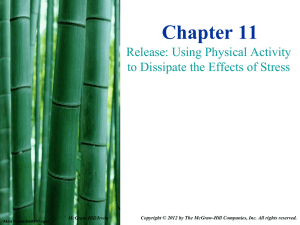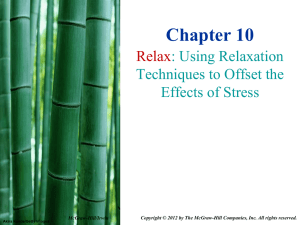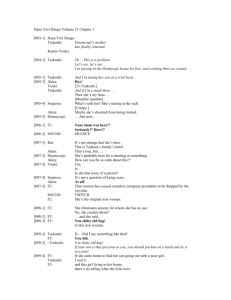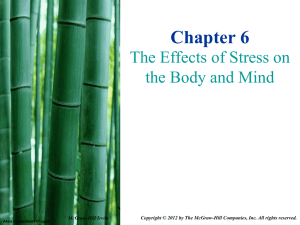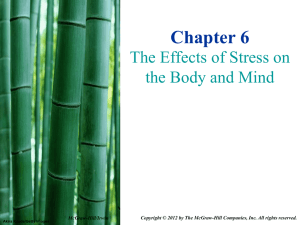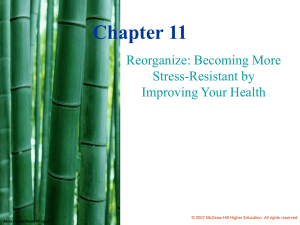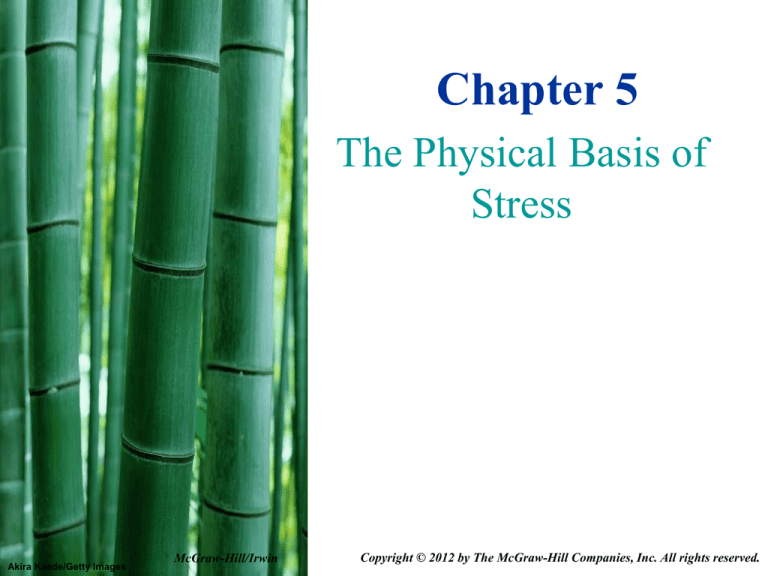
Chapter 5
The Physical Basis of
Stress
Akira Kaede/Getty Images
McGraw-Hill/Irwin
Copyright © 2012 by The McGraw-Hill Companies, Inc. All rights reserved.
Major Body Systems Involved
in the Stress Response
The endocrine system
The nervous system:
Communication
Control
Integration
Cardiovascular (circulatory) system
Transportation (sugars, salts, fats and oxygen)
Immune system
Defense - compromised
Muscular system
Support and Movement – muscle tension
The respiratory system
Gas exchange
The digestive system
Akira Kaede/Getty Images
Nutrition and excretion
5-2
General Adaptation
Syndrome (GAS):
A Review
Developed by Selye, GAS has
three distinguishable phases
Alarm – fight or flight
Resistance – idling too fast
Exhaustion – tank goes empty
Problems?
Non-specificity
5-3
Akira Kaede/Getty Images
The Nervous System and
Fight-or-Flight (An Alarm
Reaction)
Fight-or-flight stress response helps
us get out of harm’s way
Selye’s General Adaptation
Syndrome (GAS) alarm phase
Stress response: a series of phases
(ARE) that continue to exact a toll
on our bodies until we remove or
cope with the stressor that initiates it
5-4
Akira Kaede/Getty Images
Axes and Pathways
Everly & Lating: Three different pathways
The neural axis
The neuroendocrine axis (a.k.a. the
sympathoadrenomedullary system, or SAM)
The endocrine axis (contains the
hypothalamic-pituitary-adrenal-cortical
system, or HPAC)
The axes expand on Selye’s work
5-5
Akira Kaede/Getty Images
The Neural Axis (aka
neural networks)
Central Nervous System (CNS): Brain and
spinal cord
Peripheral Nervous System: All parts of the
nervous system outside of the brain and
spinal cord
Somatic System: Links spinal cord with body and
sense organs; controls voluntary behavior
Autonomic System: Serves internal organs and
glands; controls automatic functions such as heart
rate and blood pressure
Akira Kaede/Getty Images
Sympathetic: Arouses body; emergency
system
Parasympathetic: Quiets body;
most active after an emotional event
5-6
5-7
Akira Kaede/Getty Images
Fight-or-Flight: The
Brain
The fight-or-flight response
Originates with the brain’s perception of
threat
Different parts of the brain are involved in
the stress response
The cerebral cortex—covers the
cerebrum and controls higher thought
processes
Akira Kaede/Getty Images
The diencephalon—forms the central
brain core and receives and routes
5-8
messages (thalamus and hypothalamus)
5-9
Akira Kaede/Getty Images
Fight-or-Flight: The Brain
(continued)
Akira Kaede/Getty Images
The limbic system
Links the emotional brain with the
thinking, rational brain
The brain stem
Produces autonomic functions
(necessary for survival)
Is pathway for both general and
specific cortical arousal through the
reticular activating system (RAS)
The spinal cord
The lifeline between the brain and
5-10
the rest of the body
Figure 2.26
FIGURE 2.26 Parts of the limbic system. Although only one side is shown here, the hippocampus
and the amygdala extend out into the temporal lobes at each side of the brain. The limbic system
is a sort of “primitive core” of the brain strongly associated with emotion.
Akira Kaede/Getty Images
Fight-or-Flight: The
Peripheral Nervous System
The somatic nervous system
Transmits messages under our
conscious control (Run, Fight)
The autonomic nervous system
Controls functions that are unconscious
Sympathetic branch: activates stress
responses
Parasympathetic branch: deactivates
stress responses (activates relaxation
responses)
5-12
Akira Kaede/Getty Images
Fight-or-Flight: The
Endocrine System of the
Neuroendocrine Axis
Produces hormones associated
with alarm
Adrenal glands play the most
significant role in the stress
response
Epinephrine (adrenaline - fear)
Norepinephrine (noradrenaline
- anger)
5-13
Akira Kaede/Getty Images
5-14
Akira Kaede/Getty Images
Resistance: A Continuous,
Long-Term Stress Response
The physiology of resistance: The body
not at rest but also not in the throes of
alarm
Roles played by
The brain: the cerebral cortex,
diencephalon, limbic system, and brain stem
(identifies stress issues and sends messages to
the body to prepare for action)
The endocrine axes: adrenocortical,
somatotropic, thyroid, and pituitary systems
(responds to the brain to prepare the body to
act)
5-15
Akira Kaede/Getty Images
Resistance—The
Cerebral Cortex
The cerebral cortex—the key
part of the brain involved in
resistance
Our thoughts about stressors,
especially illogical thoughts, keep
them alive or allow them to
dissipate
5-16
Akira Kaede/Getty Images
Resistance—The Limbic
System
Interacts with the cortex as our
emotions interact with our
thoughts
Prolongs or reduces the stress
response
5-17
Akira Kaede/Getty Images
Resistance—The Endocrine
System
The pituitary is known as the
master gland
All activities are orchestrated by
the pituitary gland through the
hypothalamus
5-18
Akira Kaede/Getty Images
Resistance—The Adrenal
Function
The medulla secretes two key
groups of hormones
Gluccocorticoids (sugars)
Cortisol provides energy, reduces
inflammation, prolongs stress
response
Mineralocorticoids (salts)
Aldosterone keeps blood pressure
elevated
5-19
Akira Kaede/Getty Images
The Physiology of
Exhaustion
Selye believed all living things
have a finite amount of energy
to adapt to stress
When that is used up, one
suffers exhaustion
Organisms vary in how they
become exhausted
5-20
Akira Kaede/Getty Images
Exhaustion—The Weak
Link
Selye asserted all living things
have a “weak link,” the first
part to fail
Chronic stress puts a heavy
demand on strategic body parts
Heart, blood vessels, and
adrenal and thyroid glands are
most susceptible
5-21
Akira Kaede/Getty Images

